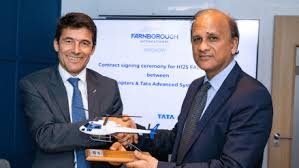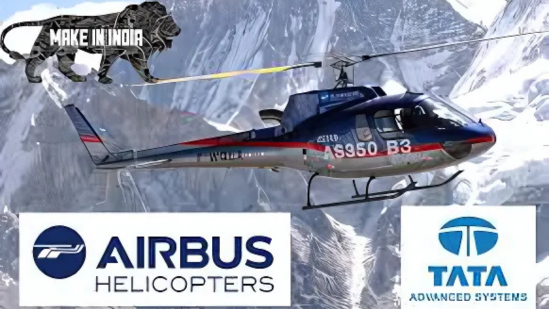
In a historic development for India’s aerospace and defense sector, Airbus, the world’s leading aircraft manufacturer, has partnered with Tata Advanced Systems Limited (TASL) to establish the country’s first privately-led Final Assembly Line (FAL) for helicopters. This collaboration not only strengthens India’s position in the global aerospace industry but also gives a major push to the Indian government’s ‘Make in India’ and ‘Atmanirbhar Bharat’ initiatives.
This is not the first time Airbus and Tata have come together. Their earlier projects, such as the assembly of the C295 military aircraft, laid the groundwork for deeper partnerships in aerospace manufacturing. Now, with the new helicopter assembly line, they aim to transform India into a manufacturing hub for the globally popular Airbus H125 helicopters, which are used for emergency medical services, law enforcement, tourism, and corporate transport.
A Final Assembly Line (FAL) is the final stage in the production of helicopters or aircraft. It is where all major components—including the body, rotor blades, engine, and avionics—are put together and tested before delivery. The decision to build an FAL in India represents a major step forward in reducing the country’s dependency on imports, creating local jobs, and fostering technological innovation.
Though the exact location of the assembly line has not been officially confirmed, reports suggest that it may be built in Hyderabad, Telangana. Hyderabad has emerged as a strong aerospace and defense hub due to its existing infrastructure and skilled talent pool. The new facility is expected to follow global safety and quality standards, and it will further solidify the city’s role in India’s aviation sector.
The significance of this collaboration cannot be overstated. For the first time, a private company is taking the lead in setting up a helicopter assembly line in a space that was traditionally dominated by public sector organizations like Hindustan Aeronautics Limited (HAL). This shift reflects the Indian government’s growing confidence in the private sector’s ability to innovate, deliver, and contribute to national defense and economic growth.
The Airbus H125 is known for its high performance, low maintenance costs, and versatility. It performs exceptionally well in hot and high conditions, making it ideal for Indian terrains, especially in regions like the Himalayas. With a wide range of applications—from air ambulance services to border surveillance—this helicopter meets both civil and government operational needs. Airbus believes that with the new facility, India can become a global supplier of the H125.
India currently has a very limited number of civil helicopters in operation—around 300—compared to thousands in countries like the United States and China. One of the major reasons for this gap is the lack of domestic manufacturing facilities and regulatory hurdles. With the new Airbus-Tata facility, experts hope to see a surge in domestic production, improved access to helicopters for various industries, and an increase in exports to neighboring countries in Asia and Africa.
Another major benefit of this assembly line is job creation. The new facility is expected to generate hundreds of skilled jobs in engineering, quality control, project management, and manufacturing. More importantly, Airbus will provide world-class training, helping Indian workers gain critical experience in aerospace assembly and testing. This skill development will be essential in building a long-term, sustainable aerospace ecosystem in India.
This collaboration also opens the door for India to become an exporter of helicopters. As the production of the H125 becomes localized, Airbus and Tata will be in a position to deliver not just to Indian customers but to clients across South Asia, Africa, and beyond. Exporting helicopters from India will not only bring in foreign revenue but also position the country as a trusted global aerospace partner.
Industry leaders have praised this move. Representatives from Airbus called it a “strong step” towards supporting India’s goal of becoming a global aerospace powerhouse, while executives from Tata Advanced Systems Limited said the project reflects their long-term commitment to building strategic aerospace capabilities in India. Government officials, too, have welcomed the project, calling it a major success for public-private partnerships in defense manufacturing.
This project is perfectly aligned with several Indian policy initiatives, including Make in India, Atmanirbhar Bharat, and the Defence Production and Export Promotion Policy (DPEPP). These policies aim to encourage foreign direct investment (FDI), promote technology transfer, and ensure self-reliance in defense production. The Airbus-Tata venture ticks all these boxes by combining global expertise with Indian execution.
The first Made-in-India helicopters could roll out in the next two to three years, according to industry estimates. Airbus and Tata also have long-term plans to expand the scope of the facility, which may eventually include the assembly of additional helicopter models, maintenance and repair services, and even the creation of R&D centers to innovate on future aircraft designs.
The partnership between Airbus and Tata Advanced Systems Limited to create India’s first privately-run helicopter assembly line is a game-changing moment for the nation’s aerospace ambitions. It demonstrates that India is not just a consumer of global defense technologies, but is ready to become a producer, exporter, and innovator in this high-value sector. By boosting local manufacturing, creating jobs, and building self-reliance, this project sets a new benchmark in the journey of India’s emerging aerospace power.































